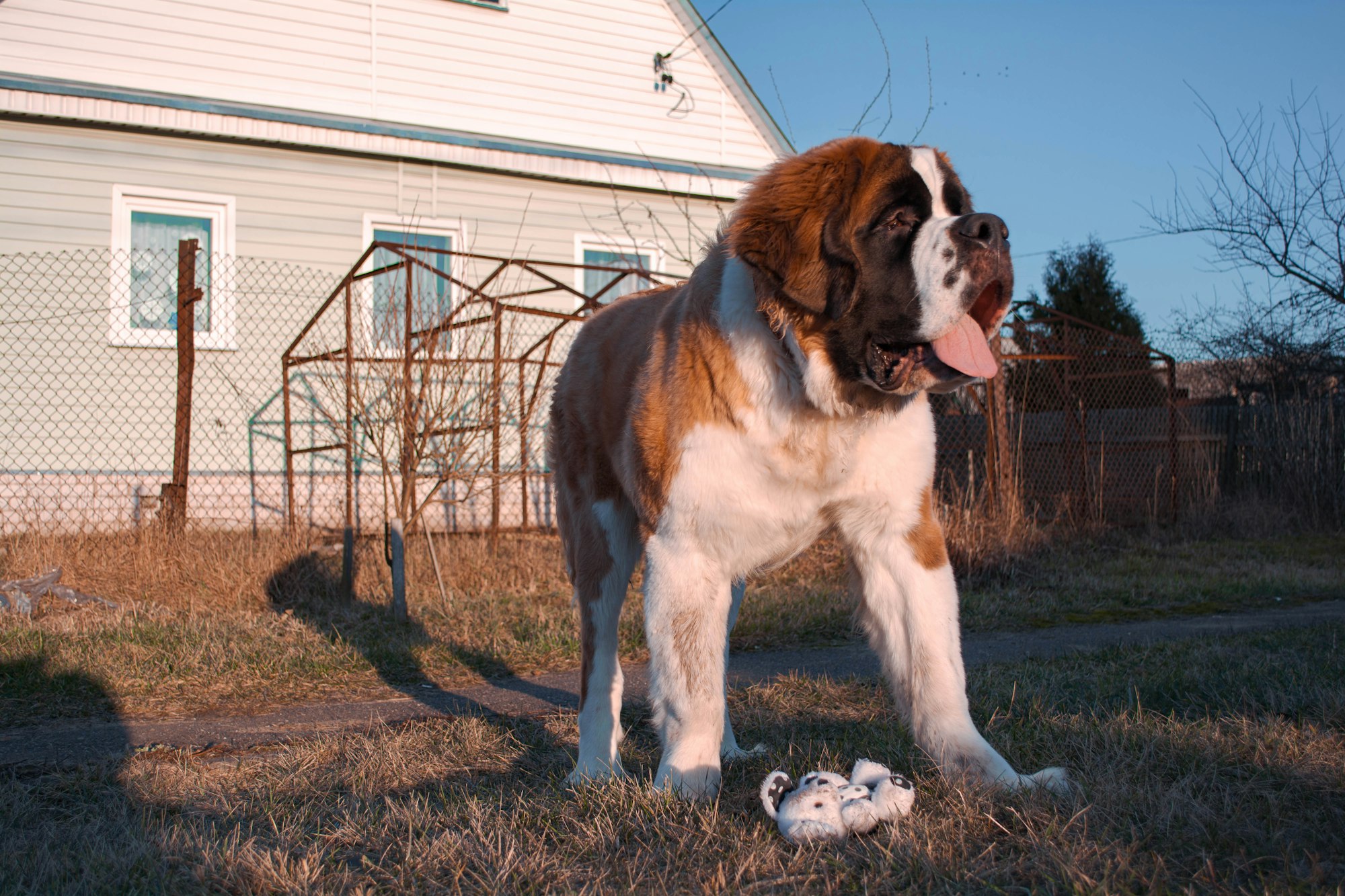The St. Bernard, with its massive size and heartwarming demeanor, embodies the ideal image of a gentle giant. Originating from the Swiss Alps, this remarkable breed has captured the admiration and hearts of dog lovers around the world. In this comprehensive guide, we'll embark on a journey into the world of the St. Bernard, exploring its history, physical characteristics, temperament, exercise needs, grooming requirements, training essentials, health considerations, social interactions, and more.

St. Bernard Introduction
The St. Bernard, known for its immense size and kind-hearted nature, has captured the imagination of people for generations. This breed's blend of strength, compassion, and loyalty makes it a cherished member of many families.
Tracing the St. Bernard's Alpine Heritage
Originating in the Swiss Alps, the St. Bernard has a rich history intertwined with rescue work and companionship. From assisting travelers in treacherous snowstorms to sharing warmth and love with those around them, the St. Bernard's heritage is one of valor and devotion.
Physical Presence: Unveiling the St. Bernard's Features
The St. Bernard's physical attributes are a testament to its strength and stature. Here's a closer look at the features that define this noble breed:
- Majestic Build: With a powerful and sturdy build, the St. Bernard exudes an air of majesty and strength.
- Distinctive Head: The breed's head is strong and expressive, featuring soulful eyes that radiate kindness.
- Signature Coat: St. Bernards has a double dog coat color. that provides insulation and protection from harsh weather.
- Elegant Coloring: Their coat comes in various combinations of white with markings of red, brindle, or mahogany.
Weight and Height of a St. Bernard
The St. Bernard's imposing size and majestic presence make it a true giant among dog breeds. Here's a closer look at their typical weight and height ranges:
Weight:
- Adult Male St. Bernards typically weigh between 140 to 180 pounds (64 to 82 kg).
- Adult Female St. Bernards generally weigh around 120 to 140 pounds (54 to 64 kg).
Height:
- Adult Male St. Bernards stand approximately 28 to 30 inches (71 to 76 cm) tall at the shoulder.
- Adult Female St. Bernards have a similar height range, typically around 26 to 28 inches (66 to 71 cm).
It's important to note that St. Bernards have a relatively slow growth rate, and their size may continue to develop until they are around two to three years old. Due to their substantial build, proper nutrition and controlled exercise during their growth stages are essential to ensure their overall health and well-being.
Heart of Gold: The St. Bernard's Temperament and Personality
Behind the St. Bernard's imposing appearance lies a heart of gold. Here's a glimpse into the St. Bernard's heartwarming temperament:
- Gentle Nature: St. Bernards are known for their gentle and affectionate nature, especially with children and their families.
- Sociable Demeanor: They often get along well with other dogs and can be welcoming to new friends.
- Watchful Guardians: While friendly, St. Bernards possess a protective instinct and can be effective watchdogs.
- Patient and Tolerant: Their patient and tolerant attitude makes them a wonderful choice for families of all sizes.
Exercise and Play: Catering to the St. Bernard's Needs
Meeting the exercise needs of a St. Bernard involves striking a balance between their size and energy levels. Here's a guide to keeping your St. Bernard happy and healthy:

- Moderate Activity: While they have a calm demeanor indoors, St. Bernards still need daily exercise to maintain their well-being.
- Leisurely Walks: Regular walks provide physical activity and mental stimulation, but avoid overly strenuous exercise due to their size.
- Interactive Play: Engage their minds with interactive games and puzzle toys, keeping their intelligence sharp.
- Supervised Playdates: Social interactions with other dogs can be enjoyable, but supervision is essential due to their size.
Grooming Grace: Nurturing the St. Bernard's Coat
Caring for the St. Bernard's coat ensures both their comfort and appearance. Here's a stepwise approach to grooming your St. Bernard:
- Regular Brushing: Brush their coat regularly to prevent matting and remove loose fur, especially during shedding seasons.
- Bathing Routine: Bathe your St. Bernard as needed to maintain their coat's cleanliness and health.
- Ear and Dental Care: Clean their ears regularly and attend to their dental hygiene to prevent potential issues.
Training the Gentle Giant: Building Bonds and Obedience
Training a St. Bernard involves fostering a strong bond and ensuring their obedience. Here's a stepwise approach to effective training:
- Early Socialization: Introduce your St. Bernard to various people, animals, and environments from a young age.
- Positive Reinforcement: Use positive reinforcement techniques, such as treats and praise, to encourage desired behaviors.
- Consistency and Patience: Be patient and consistent in your training approach, taking their size and temperament into account.
- Obedience Commands: Teach essential commands like sit, stay, and recall to ensure their safety and well-being.
Health Concerns in St. Bernards
The St. Bernard, with its noble and majestic appearance, is a beloved breed that brings joy and companionship to countless families. However, like all breeds, St. Bernards may be prone to certain health concerns that owners should be aware of to provide the best care possible. Regular veterinary check-ups, proper nutrition, exercise, and preventive measures are key to ensuring the well-being of your St. Bernard. Here are some common health considerations for this breed:
- Elbow and Hip Dysplasia: St. Bernards, due to their size and weight, may be susceptible to elbow and hip dysplasia, which can lead to discomfort and reduced mobility. Regular exercise and maintaining a healthy weight can help mitigate these issues.
- Gastric Torsion (Bloat): Large, deep-chested breeds like St. Bernards are at a higher risk of developing bloat, a potentially life-threatening condition where the stomach twists. Feeding multiple small meals throughout the day, avoiding vigorous exercise after meals, and providing elevated feeding stations can help reduce the risk.
- Cardiac Conditions: St. Bernards can be prone to certain heart conditions, such as dilated cardiomyopathy. Regular veterinary examinations and monitoring can help detect and manage these issues.
- Osteosarcoma: Like many large breeds, St. Bernards may be at a higher risk of developing bone cancer. Early detection and treatment are crucial for a positive outcome.
- Entropion: Entropion, a condition where the eyelids roll inward, can occur in St. Bernards. Regular eye examinations can help identify and address this issue.
- Obesity: Due to their size, St. Bernards are at risk of obesity, which can exacerbate other health concerns. A balanced diet and regular exercise are essential for maintaining a healthy weight.
- Joint Issues: Arthritis and joint problems can develop over time, especially in older St. Bernards. Providing joint supplements and managing their activity levels can help alleviate discomfort.
- Skin Problems: St. Bernards' skin folds and wrinkles can be prone to infections if not kept clean and dry. Regular grooming and hygiene practices are important.
- Heat Sensitivity: St. Bernards are sensitive to heat due to their thick coat and size. Avoid excessive heat and ensure they have access to shade and water during warm weather.
- Anesthesia Sensitivity: St. Bernards may have unique sensitivities to anesthesia, which should be taken into consideration during medical procedures.
By staying informed about these potential health concerns and being proactive in your St. Bernard's care, you can help ensure they lead a happy, healthy, and fulfilling life by your side.
Social Connections: Canine and Human Interactions
Socialization is key to shaping your St. Bernard's behavior. Here's how to foster positive interactions with both canines and humans:
- Early Exposure: Introduce your St. Bernard to various people, dogs, and situations during their early development.
- Positive Encounters: Use positive reinforcement to reward calm and well-mannered behavior during social interactions.
- Training Classes: Enroll them in puppy training and socialization classes to develop their social skills and obedience.
St. Bernards as Beloved Family Companions
As family members, St. Bernards brings a unique blend of companionship and protection. Here's a closer look at their role within the family:
- Loyal Companionship: St. Bernards are fiercely loyal and often form deep bonds with their human family members.
- Gentle with Children: Their gentle nature makes them well-suited for households with children, acting as patient playmates.
- Watchful Guardians: While friendly, St. Bernards can also serve as effective watchdogs, alerting you to any potential threats.
- Emotional Connection: Their affectionate demeanor and soulful eyes make them emotionally attuned to their family's needs.
Roles of St. Bernards in Society
St. Bernards, with their imposing stature and gentle demeanor, have played significant roles in society throughout history. From their origins in the Swiss Alps to their present-day contributions, these majestic dogs have earned a place of admiration and respect. Here, we explore the various roles that St. Bernards have fulfilled in society:
- Alpine Rescuers: St. Bernards gained worldwide recognition for their heroic work as Alpine rescuers in the treacherous mountains of the Swiss Alps. Equipped with an exceptional sense of direction and an ability to locate lost travelers in snowstorms, they were essential companions to the monks of the St. Bernard Hospice. These dogs played a vital role in saving lives, often by locating stranded travelers and providing them with warmth and companionship until help arrived.
- Search and Rescue: The St. Bernard's innate ability to locate and assist those in need has extended to modern-day search and rescue operations. Their acute sense of smell, strong instincts, and unwavering determination make them valuable assets in locating missing persons and providing comfort during emergencies.
- Therapy and Assistance Dogs: St. Bernards have a natural affinity for providing comfort and emotional support. Their calm and gentle nature has led them to excel as therapy dogs, visiting hospitals, nursing homes, and rehabilitation centers to bring smiles and companionship to individuals facing challenges. Additionally, their size and strength make them potential candidates for assisting individuals with mobility issues.
- Canine Companions: Beyond their working roles, St. Bernards are cherished companions and beloved members of countless households around the world. Their loyal and affectionate nature, combined with their protective instincts, make them wonderful family dogs. St. Bernards often form deep bonds with their human families, offering unwavering companionship and a source of comfort.
- Ambassadors of Goodwill: St. Bernards also serve as ambassadors of goodwill, representing their breed and embodying qualities of kindness, loyalty, and compassion. Through public appearances, events, and social interactions, they spread positivity and leave lasting impressions on people of all ages.
- Show and Performance Dogs: St. Bernards continue to participate in dog shows and performance events, showcasing their conformation, obedience, and agility skills. Their elegant appearance and impressive presence make them stand out in the show ring, while their willingness to learn and engage in various activities showcases their versatility.
In summary, St. Bernards has left an indelible mark on society by performing a range of roles, from life-saving rescues to providing comfort and companionship. Their contributions continue to evolve, reflecting their innate qualities and the bond they share with humans. Whether in the mountains, therapy settings, homes, or various public engagements, St. Bernards exemplifies the true spirit of loyalty and service.

Myths and Truths: Clarifying Common Misconceptions
Dispelling misconceptions about St. Bernards helps paint a more accurate picture of this breed. Here's a stepwise exploration of common myths:
Myth 1: St. Bernards Always Need Cold Weather
- Fact: While they have a history of Alpine rescue work, St. Bernards can adapt to various climates and living conditions.
Myth 2: St. Bernards Are Always Drooling
- Fact: While some drooling can occur, not all St. Bernards drool excessively. Individual tendencies can vary.
Myth 3: St. Bernards Are Always Lethargic
- Fact: St. Bernards have a calm demeanor, but they also enjoy play and exercise. Regular activity is important for their well-being.
Myth 4: St. Bernards Are Too Big for Families
- Fact: With proper training and socialization, St. Bernards can be wonderful family companions and adapt well to home life.
Average Price of a St. Bernard
When considering adding a St. Bernard to your family, it's important to be aware of the potential costs involved. The average price of a St. Bernard can vary based on factors such as breeder reputation, lineage, geographical location, and whether the dog is intended for show, breeding, or pet purposes.
On average, you can expect to pay between $1,500 to $2,500 for a St. Bernard puppy from a reputable breeder. This price range may fluctuate depending on demand and other market factors. It's crucial to research and connect with breeders who prioritize the health, well-being, and ethical treatment of their dogs.
Keep in mind that the initial purchase price is just one aspect of the expenses associated with owning a St. Bernard. Additional costs may include veterinary care, dog food, grooming, training, and potential medical bills. Responsible ownership also involves providing a suitable living environment and ensuring the happiness and welfare of your furry companion.
For those who are passionate about the breed and willing to invest time, effort, and resources, St. Bernard's companionship and gentle nature can bring immeasurable joy to your life.
Embracing the St. Bernard: A Lifelong Journey
In conclusion, the St. Bernard's immense size is matched only by its immense heart. This breed's devotion, kindness, and gentle nature make it a treasured companion for those who appreciate its unique qualities.
As you embark on the journey of sharing your life with a St. Bernard, remember the importance of providing them with love, care, and a suitable environment. With the right upbringing and attention, your St. Bernard will reward you with unwavering loyalty and a lifetime of heartwarming moments.
Frequently Asked Questions
1. Are St. Bernards good with children?
Yes, St. Bernards are known for their gentle and patient nature, making them great companions for children.
2. Do St. Bernards require a lot of exercise?
While they have a calm demeanor, St. Bernards do benefit from regular exercise to maintain their health and well-being.
3. Can St. Bernards adapt to apartment living?
While their size may pose challenges in small spaces, St. Bernards can adapt to apartment living with proper exercise and care.
4. Are St. Bernards prone to health issues due to their size?
St. Bernards may be susceptible to certain health concerns, particularly joint and cardiac issues. Regular veterinary care is essential.
5. Do St. Bernards get along with other pets?
With proper socialization, St. Bernards can coexist with other pets, but supervision and training are important.

